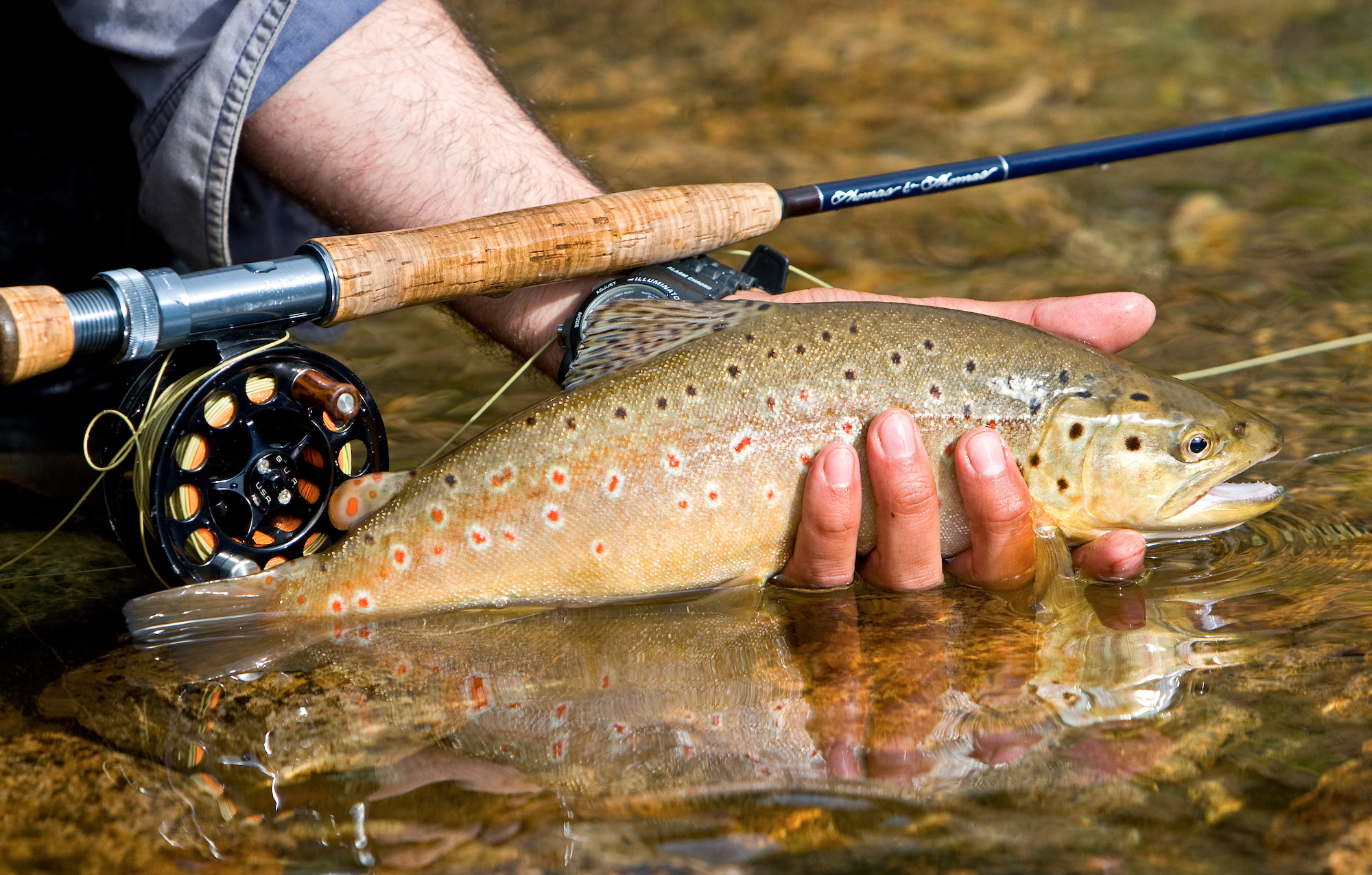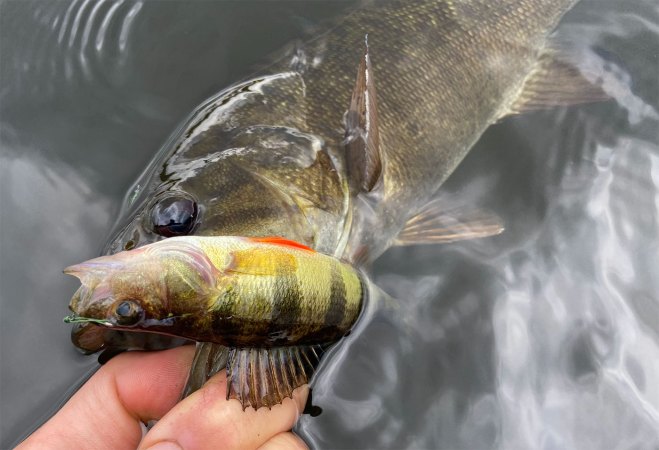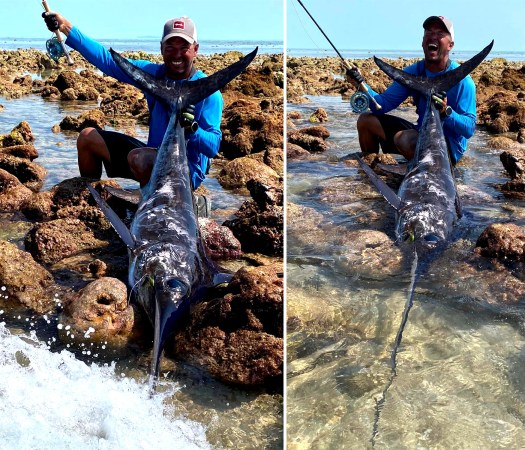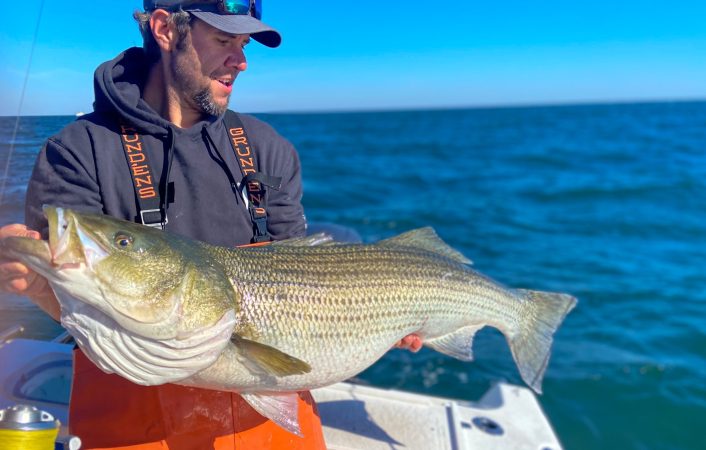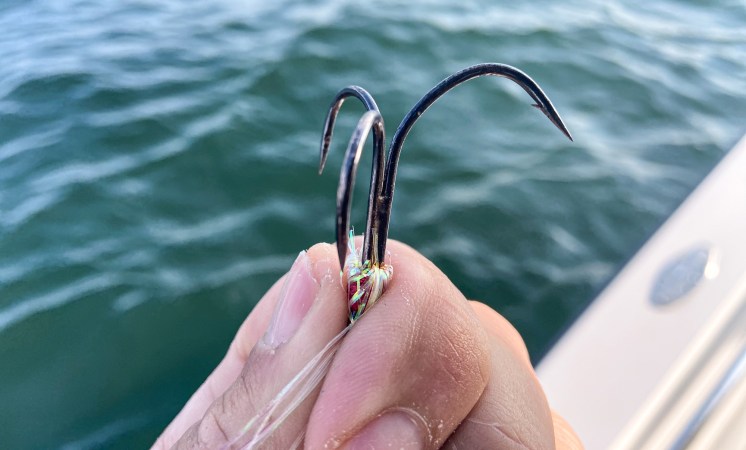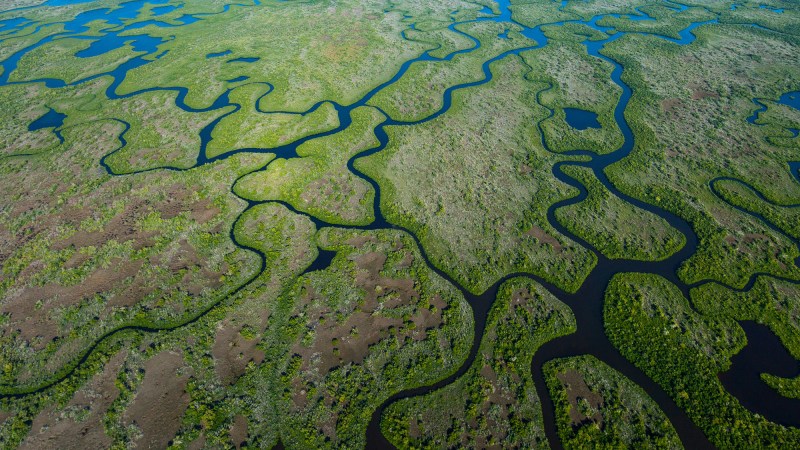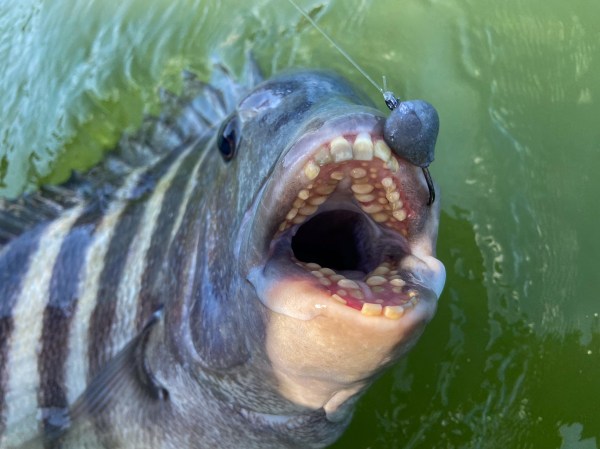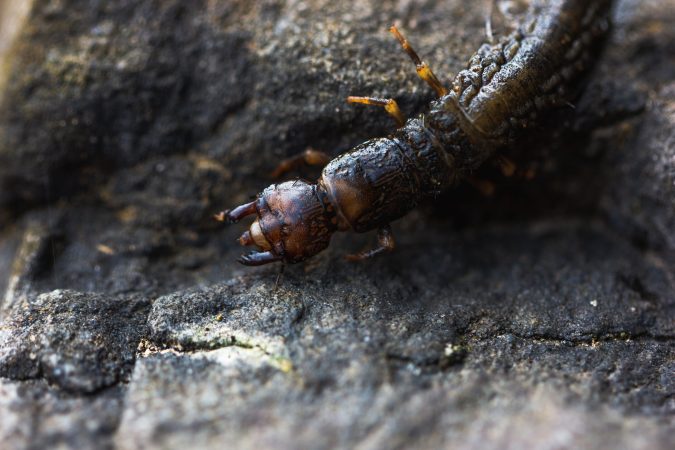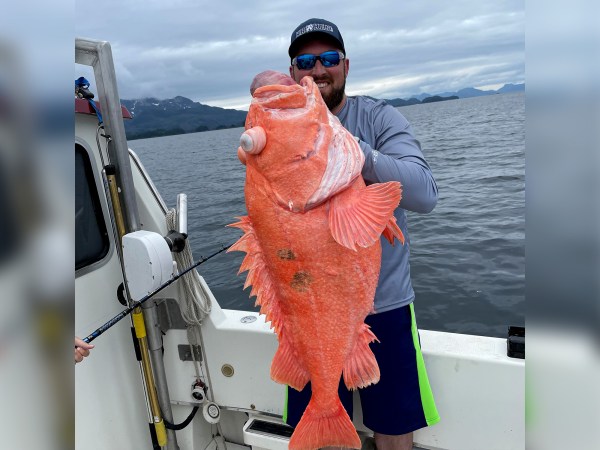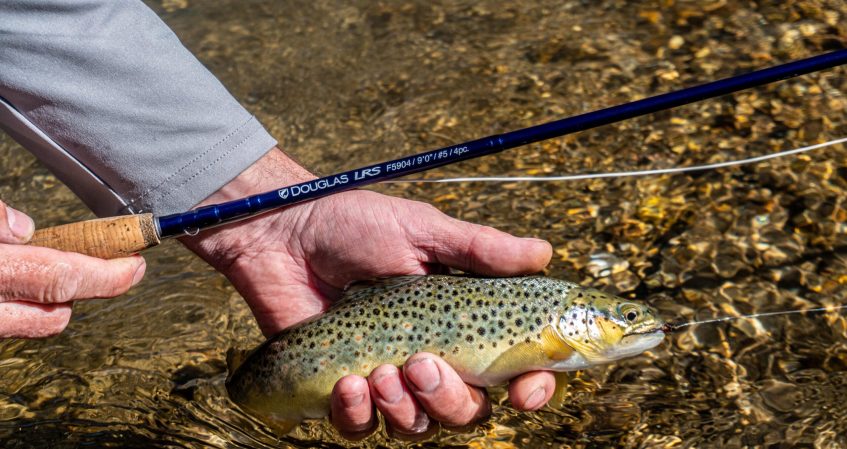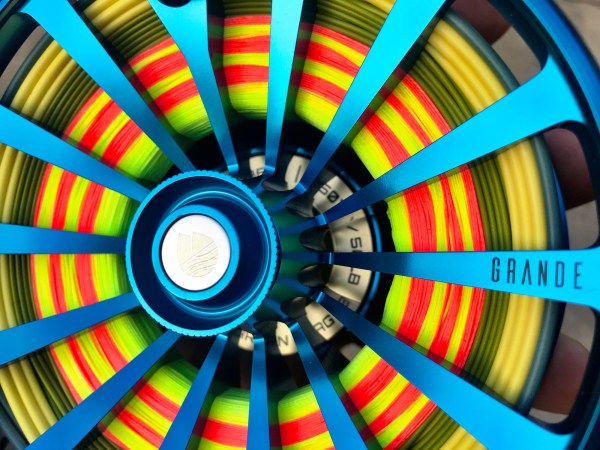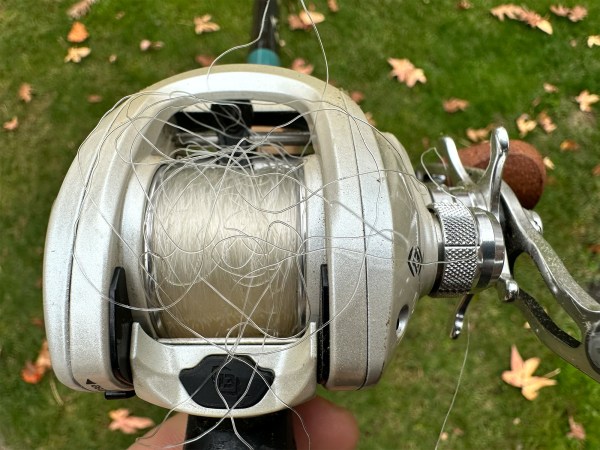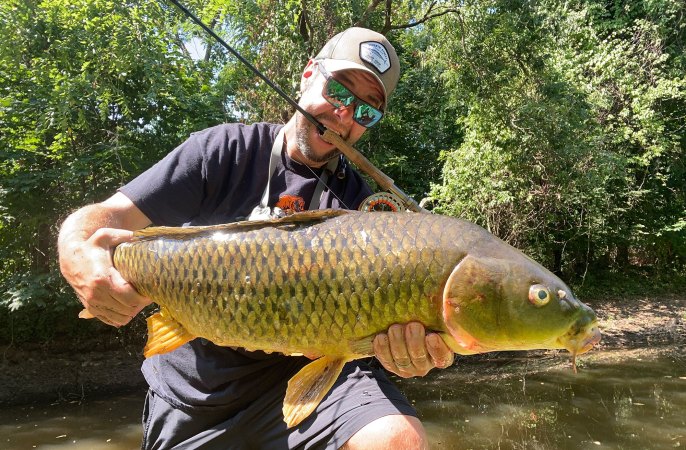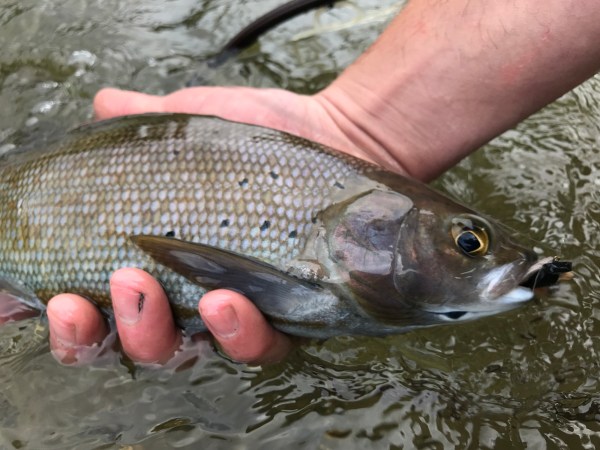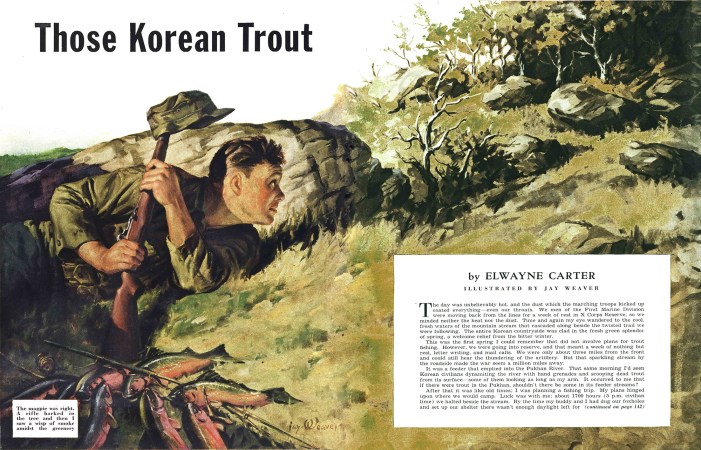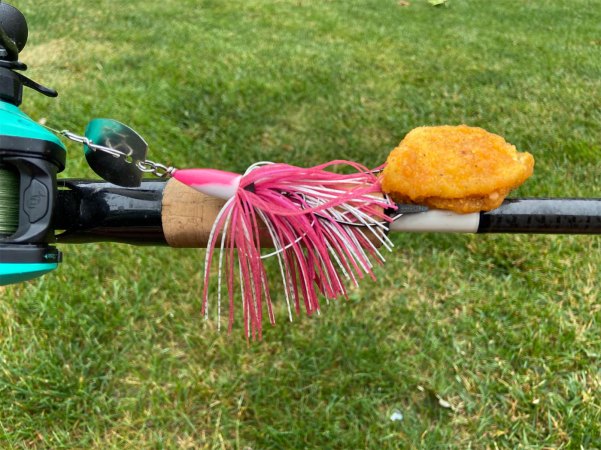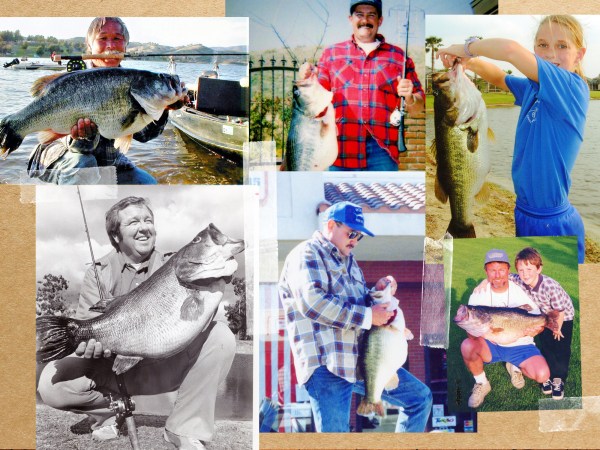Fly fishing at its most basic level is just another technique for catching fish. On a deeper level, it’s both a blood sport and an art form that is partly based around making the act of fishing more challenging, and therefore, more rewarding. It’s this paradoxical approach that separates fly fishing from more conventional ways of fishing.
Fly fishing requires specialized tackle, namely fly rods and fly lines, to cast lightweight lures known as flies—which traditionally imitated insects but can now imitate a vast array of fish food. The rods themselves are longer, thinner, and more flexible than regular spinning or casting rods, and the thick, weighted lines help deliver these flies to the fish effectively.
In this complete guide, we define the sport of fly fishing and look back on its rich history. We also walk through how to get started as a new fly angler, including the gear and techniques required to start catching fish. You can read straight through the story, or click on the table of contents below to jump around.
- What Is Fly Fishing?
- Understanding and Buying Fly Fishing Gear
- Key Fly Fishing Technqiues
- Finding a Place to Fish
- A Brief History of Fly Fishing
- FAQs
What Is Fly Fishing?
Fly fishing can be hard to define because of how much it has changed and evolved over the years. The sport that we’re familiar with today was invented in Europe specifically as a means of catching trout and other salmonids in fresh water on imitations of small insects, or flies.
This seemed a logical approach because aquatic insects make up the majority of a trout’s diet. As a practical matter, however, anglers quickly found that it was impossible to throw these minuscule lures with traditional rods and casting techniques, which rely on the weight of a lure or bait to effectively throw it. This necessity gave birth to a whole new approach to casting—one that revolved around the use of a weighted fly line.
Fast forward to the 21st century, and the sport has far outgrown the European trout and salmon fishing world. Thanks to advances in gear and new techniques, anglers can now catch nearly every fish that swims using a fly rod. (Some folks are even getting into fly fishing for carp these days.) In a sense, the sport of fly fishing has grown so far from its traditional roots that it can sometimes be hard to separate it from conventional fishing.
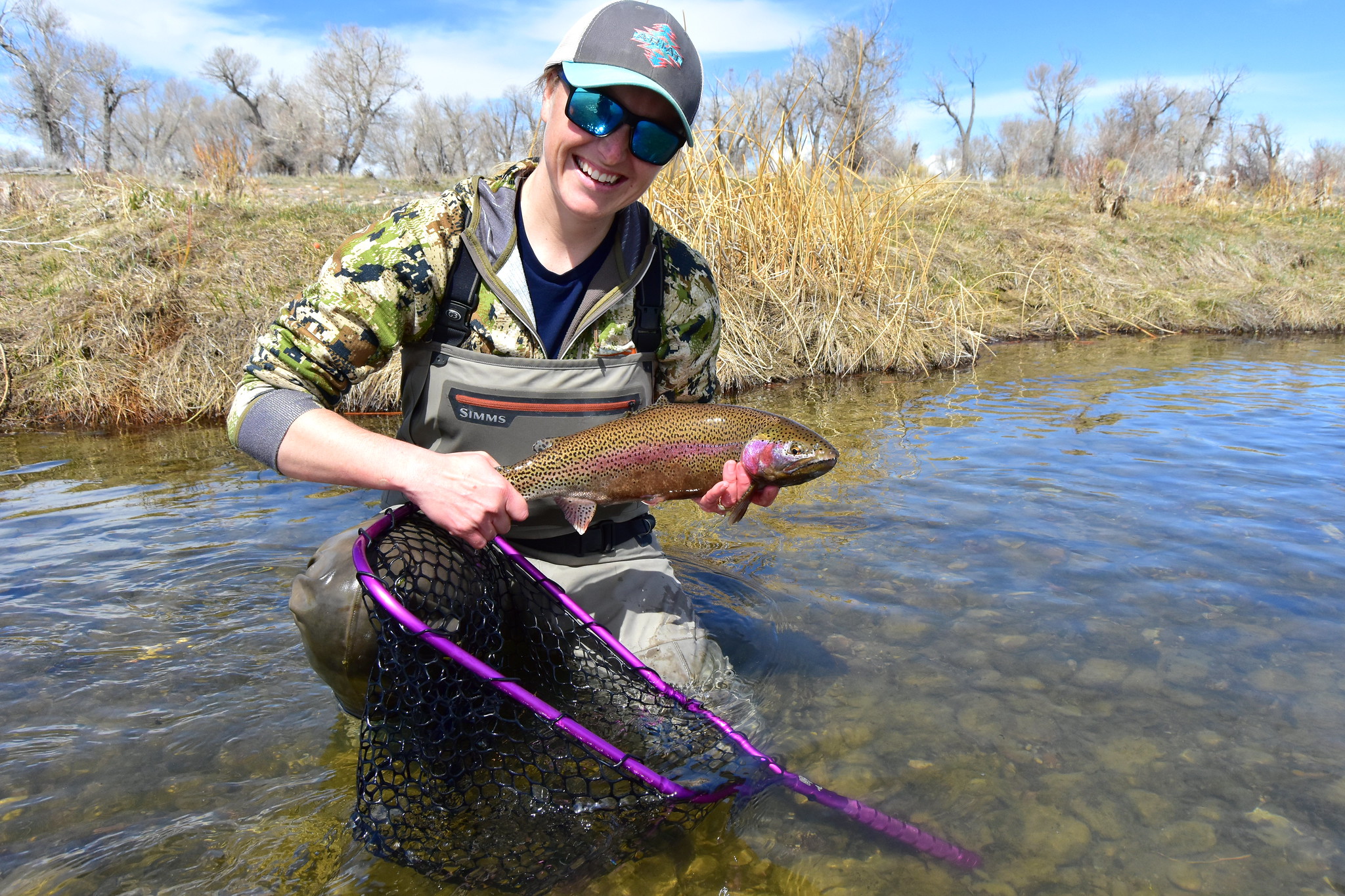
In Alaska trout fishing circles, for example, the old-school yarn flies that imitated salmon eggs have been tossed aside in favor of small plastic beads. And in some dark corners of the steelheading world, anglers are spooling their fly reels with monofilament and using extra weights to get longer, better drifts in deep rivers. Meanwhile, you can run offshore and catch a marlin on a fly rod, but you’ll probably have to rely on teaser lures that are trolled or cast out with a spinning rod if you want to have a chance at hooking one on the fly.
On the other end of the spectrum are the fly fishing purists. These highfalutin anglers refuse to trout fish with anything besides a dry fly (a fly that floats the surface) made of fur and feathers lashed to a hook.
I tend to fall somewhere in the middle. By my own definition, fly fishing is a time-honored technique that relies on casting a fly line (not monofilament) with a fly rod to fool fish with artificial patterns made of natural and/or synthetic materials.
Understanding and Buying Fly Fishing Gear
If you want to get into fly fishing, you’ll need to buy some specialized gear and learn some new techniques. Here’s a run down of the key tools you’ll need:
The Fly Rod
A fly rod is the first piece of equipment you’ll need to purchase. These rods are longer, thinner, and whippier than conventional spinning and casting rods. They tend to be more expensive as well, with some of the best saltwater fly rods and other high-end models costing more than $1,000. But there are plenty of options in the sub-$200 range, including some of the best fly fishing combos for beginners.
The key difference between fly rods and conventional rods is how they function when casting. A conventional rod casts the weight of the lure or bait, and the fishing line comes along for the ride. A fly rod casts the weight of the line, and the fly comes along for the ride. (More on casting techniques below.)
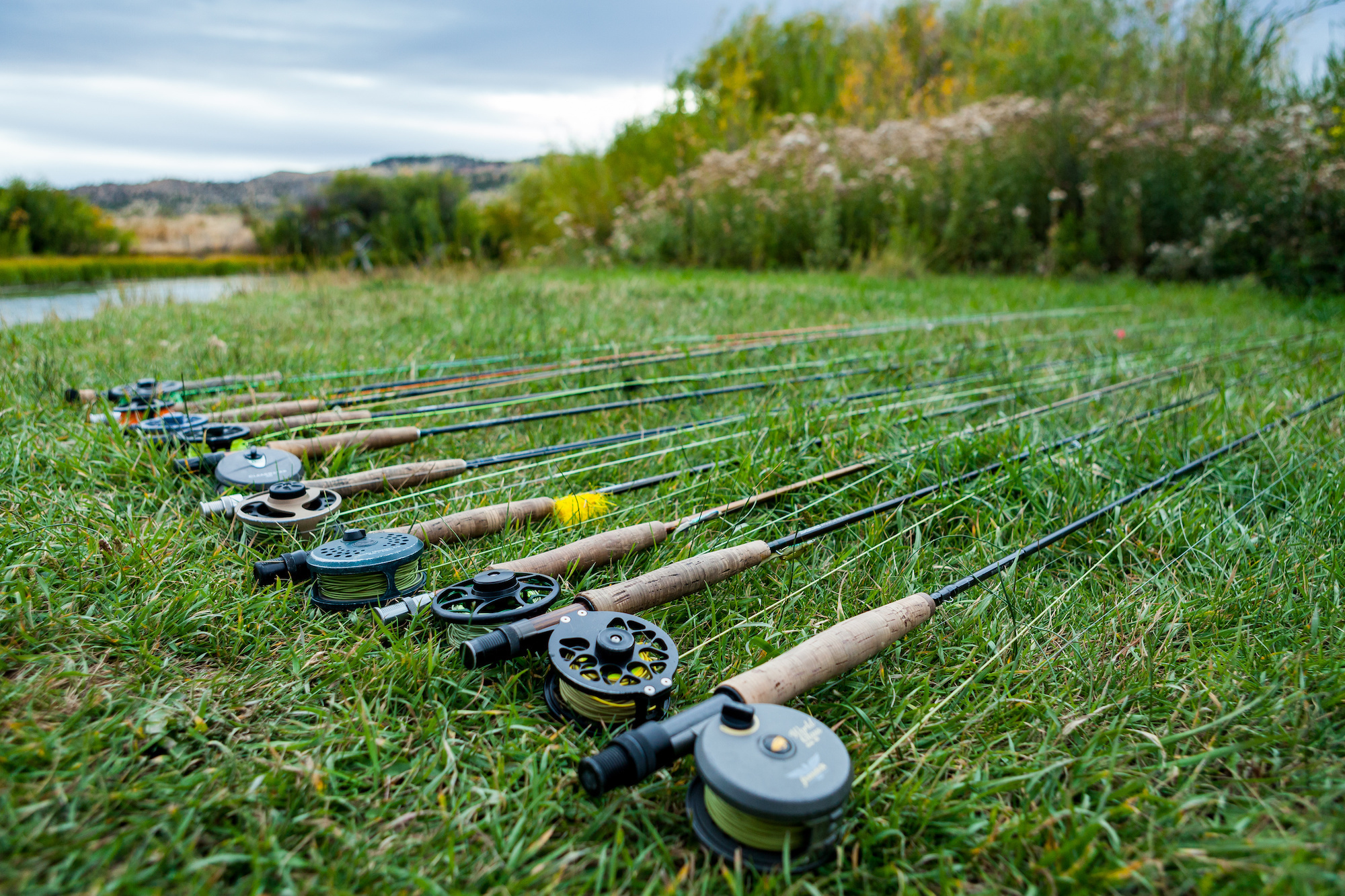
Fly rods come in various weights, which translates to the thickness of the rod and its ability to throw different sized flies to different sized fish. The typical range is from a 1-weight to a 14-weight. A 1-weight is best for ultralight techniques like fishing a small creek for brook trout, while a 14-weight is made for battling marlin, giant trevally, and other big saltwater species. A 5- or 6-weight rod would fall right in the middle of this range, and these have long been considered the best trout fly rods. These weights also work great for targeting bass and other game fish.
The standard length for a fly rod is nine feet, and most modern rods break down into four pieces for easy transport. Slightly shorter rods (seven to eight feet) are favored by anglers fishing with lighter-weight rods in tight quarters, while 10-footers are sometimes preferred by anglers in boats or on bigger water.
The rods described above would all be classified as single-handed fly rods, which is what most people are familiar with. But there are also double-handed rods, known as spey rods, which are even longer (11 to 14 feet) and designed for fishing wide, fast-flowing rivers. They’re most often used by anglers targeting steelhead and salmon. On the other end of the fly rod spectrum are tenkara rods. Invented in Japan, these long (11 to 15 feet) telescoping rods are the cane poles of the fly-fishing world.
The Fly Reel
Just like a conventional rod-and-reel setup, all fly rods (with the exception of tenkara) should be paired with a fly reel. Modern reels consist of a round spool with a handle that attaches to a reel frame, which features a pair of friction plates that create what’s known as “drag” by regulating the tension or force required to take the line off the spool. Winding on the reel handle takes line in, and the line is pulled off the reel by hand.
When compared to conventional spinning and baitcasting reels, fly reels are more basic with fewer mechanical parts. Functionally, the biggest difference is that conventional reels feature improved gear ratios (such as 6:1 or 7.5:1), which allow the spool to spin multiple times for every crank of the reel handle. A fly reel, on the other hand, has a 1:1 gear ratio, meaning that for each turn of the handle the spool rotates one turn.
The Fly Line
The line used in fly fishing is actually made up of three different components: the fly line, backing, and leader.
The fly line itself is the thick, colored line that helps deliver the fly. These weighted lines are classified like fly rods, with different weighted lines designed to pair with different weighted rods. (A 5-weight fly line, for example, is designed to cast with a 5-weight rod.) They’re also tapered, and the standard these days is known as a “weight-forward” taper. This means the line gradually gets thicker toward the business end, and it makes casting easier.
Aside from the line’s weight and taper, fly lines are classified into two main categories: floating lines and sinking lines. (There are also intermediate and sink-tip lines, which lie somewhere in between.) Floating lines have traditionally been the go-to choice for fly fishing, and for most fishing situations, a weight-forward floating fly line is all you really need. These are made of braided nylon cores coated with PVC, and they’re treated with various substances that keep the line afloat and allow it to “shoot” through the guides.
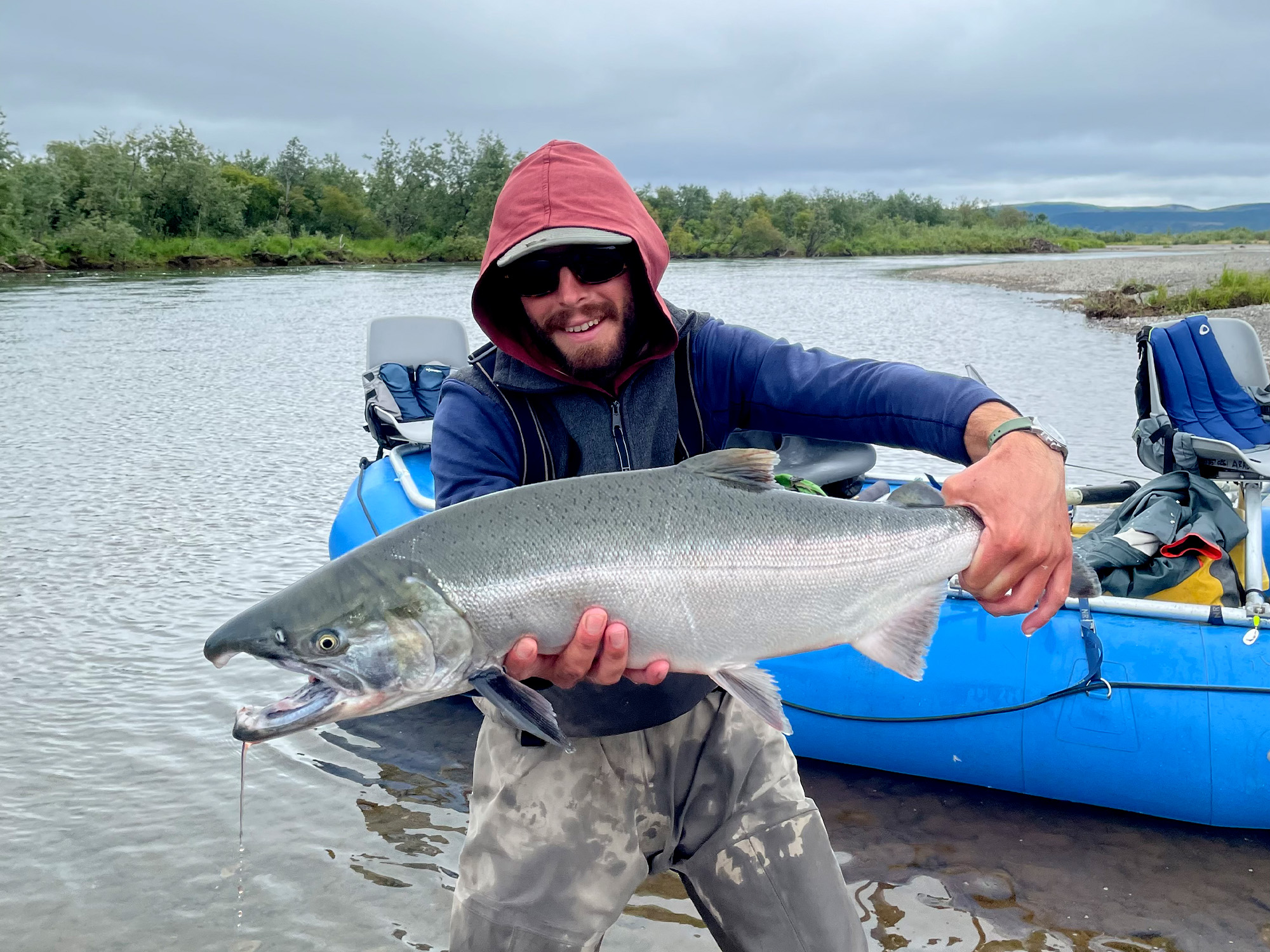
Floating fly lines designed for single-handed rods are typically around 90 feet in length. They should be cleaned periodically to maintain maximum flotation and slickness.
Since most fly reels can hold upward of 200 yards of line, a thin diameter line known as “backing” is what fills the extra space on the spool. This braided nylon line is typically 20- to 30-pound test, and it’s wound around the spool and connected to the tail end of the fly line. It’s not used in casting and is usually only seen when a big fish pulls a lot of line off the reel.
The “leader” is the clear fishing line that connects the head of the fly line to the fly itself. Most leaders are around six to nine feet in length, and they’re typically made of monofilament or fluorocarbon. These lines are also tapered, but this taper is in reverse compared to a weight-forward fly line: the thicker butt section gradually gets narrower toward the tip. When combined, these tapers help transfer the energy smoothly and efficiently from the caster’s hand to the tip of the leader.
Selecting the thickness of the leader is up to the angler and depends on the fishing situation. Long, thin leaders allow for light presentations but break easily, while short and stout leaders are much stronger but lack finesse. Most anglers will also tie on a short section of tippet to the end of their tapered leader. This clear line is made of the same material as the leader, and it helps preserve the tapered leader so it doesn’t get shorter and shorter as you change your flies.
The Fly
The most interesting part of any fly-fishing setup is the fly itself. Flies are what anglers geek out over the most, in part because the options are as limitless as the water bodies where we throw them. Flies can be as simple or as complex as the imagination allows. The art of fly tying is a pastime in and of itself, and there are people who tie flies religiously but will never fish a day in their lives.
For those of us who like to catch fish, we can divide the almighty fly into three basic categories: dry flies and other top-water patterns, nymphs, and streamers. These can imitate everything under the sun, including eggs, worms, bugs, baitfish, frogs, shrimp, mulberries, and mice.
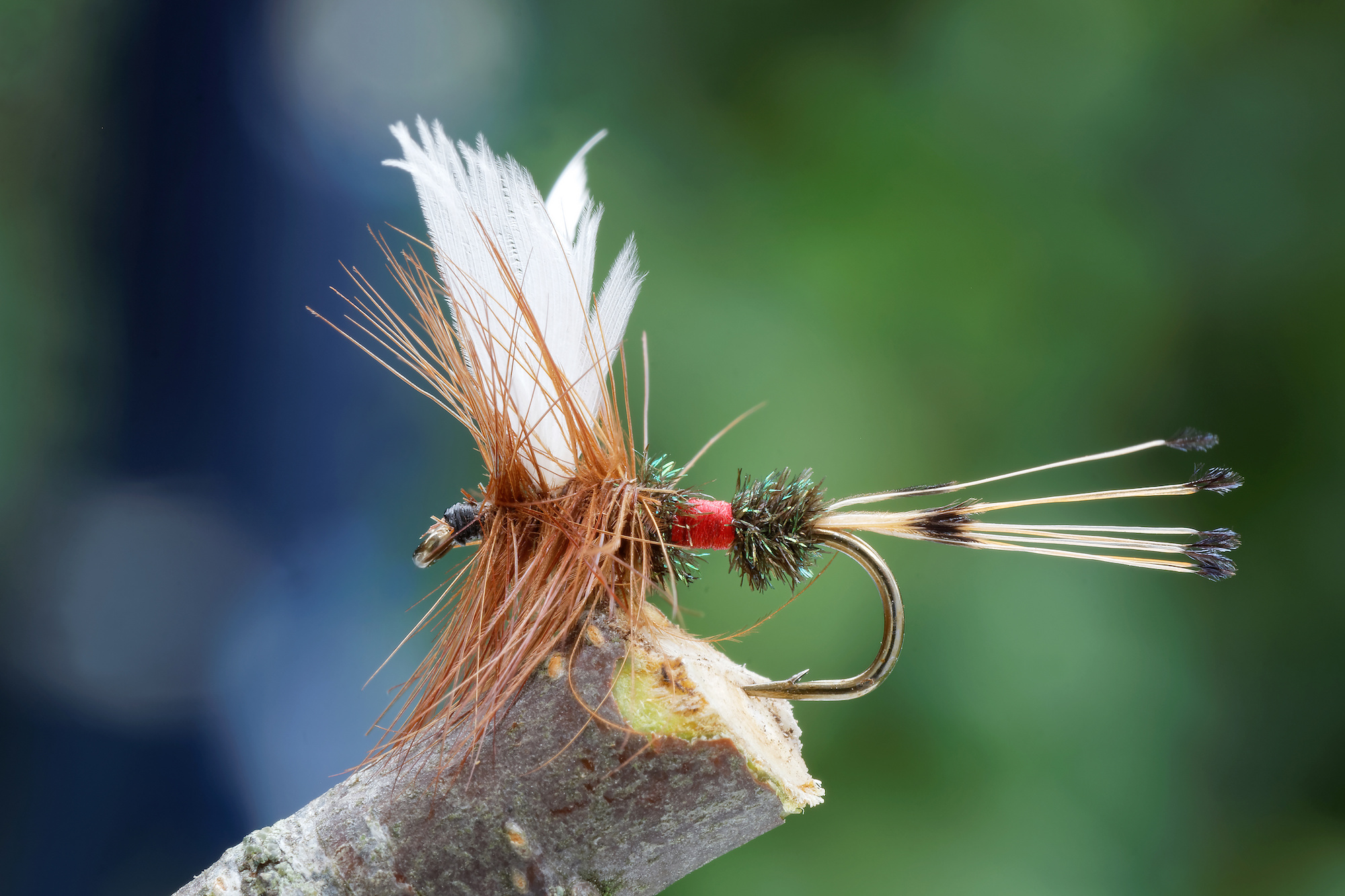
Dry flies are designed to imitate the adult form of an aquatic insect, such as a caddisfly, mayfly, or stonefly. Other bug types include terrestrial insects (like grasshoppers and ants) and midges (think mosquitos, but smaller). Dry flies are designed for and most often used in trout fishing. Because these flies float on the surface, the angler can usually see the fish eat them. This is part of the draw of dry-fly fishing—as is “matching the hatch,” which requires the angler to pick out a fly that imitates the natural bugs the fish are currently feeding on. This changes depending on when and where you’re fishing.
There are also topwater flies that imitate forage beyond bugs. Examples include poppers, sliders, gurglers, and mice patterns. These are usually fished more actively on the surface, as they’re meant to imitate critters like frogs, wounded baitfish, and swimming rodents. They can be used to target trout, along with bass, pike, and other predatory fish in both freshwater and saltwater.
Nymphs are subsurface flies that imitate the larval forms of aquatic insects. These weighted patterns are usually small, and they’re fished near the bottom of a stream or lake. They’re used mostly for trout fishing, but any fish that eats bugs will eat a well-placed nymph.
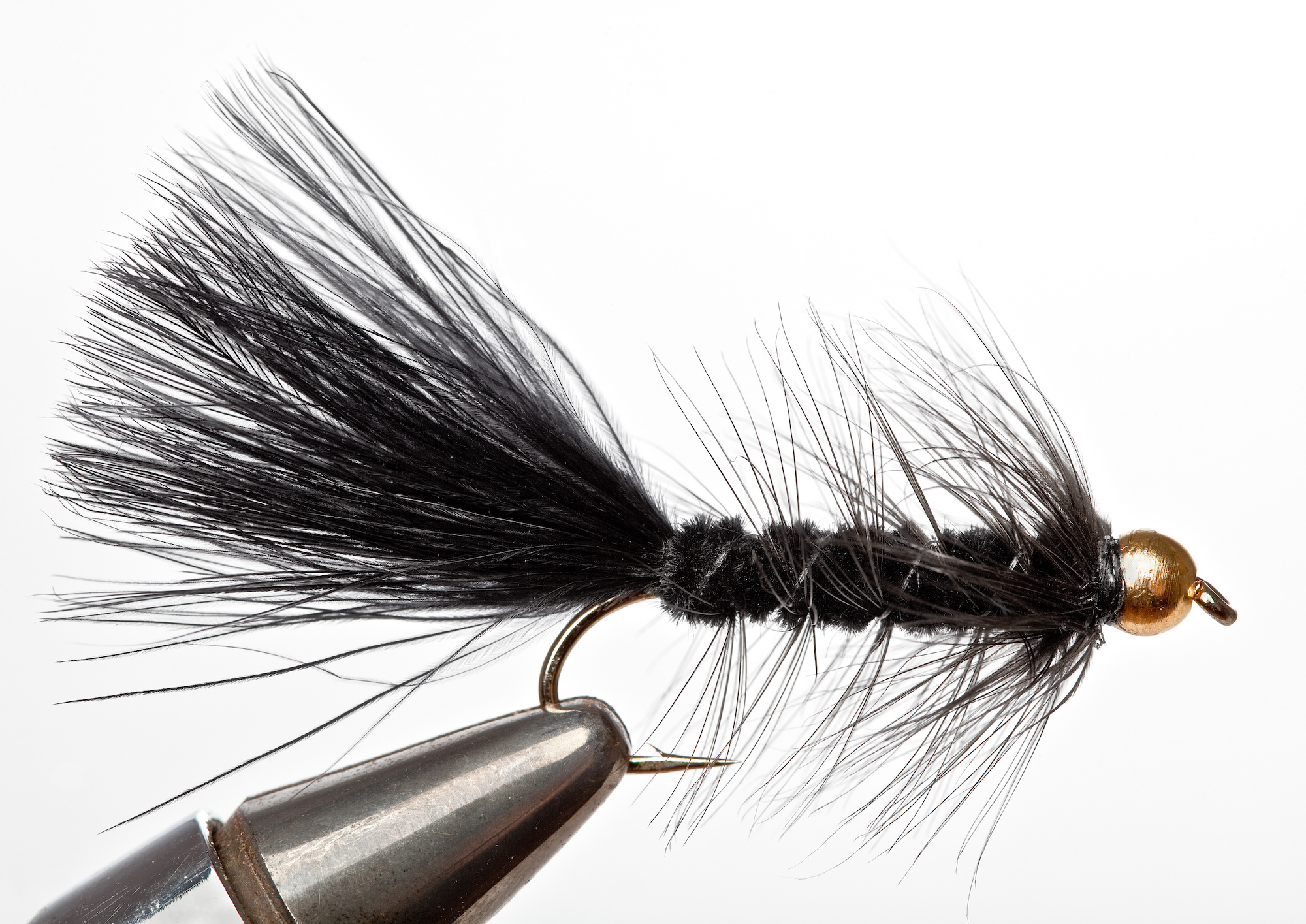
Streamers are another type of subsurface fly. They’re bigger than nymphs, as they imitate larger forage like shad, minnows, sculpin, and other baitfish. They can also imitate things like crawfish and leeches. Because they’re supposed to be moving critters, these flies are fished more actively than nymphs or dry flies. This means the angler is imparting action on the fly—much like a conventional fisherman would twitch a jig or work a crankbait. Streamers are incredibly versatile, and they can be used to target nearly any fish that swims in freshwater or saltwater.
Other Important Tools for Fly Fishing
Aside from the basic rod-and-reel setup and the lines and flies themselves, there are a few other important tools that fly anglers use. These essentials include:
- A valid fishing license
- Forceps (also known as hemostats) or pliers for unhooking fish
- Nippers or nail clippers for cutting line
- Different sized tippet and leader material
- Floatant and desiccant if using dry flies
- Small weights (also known as split shot) and strike indicators (a fancy word for bobbers) if using nymphs or streamers
- Fly boxes to keep your flies organized
- A hip pack, backpack, bag, or vest to keep all your essential gear in
- Waders if you’re fishing in cold water. A good pair of breathable chest waders are worth their weight in gold when you’re standing in the water all day. If you’re going to be wading on slick, rocky rivers, invest in a pair of stocking-foot waders along with some quality wading boots. (Boot-foot neoprenes are great for sitting in a cold duck blind, but they’re not so great for rowing or walking up a river.)
- Aquaseal works great for patching waders at home
- Polarized sunglasses will help with sight casting to fish. More importantly, they should be used as eye protection—both from the sun and from the small hooks that are whizzing by your head
Optional tools that come in handy:
- A landing net. This is more important when catching and releasing, as it allows you to land fish quicker and keeps handling to a minimum
- A hook file for keeping hooks sharp. This is more important when targeting large, predatory fish with hard mouths
- Nail knot tool or Ty Rite tool to make tying knots easier
- Stream thermometer
Key Fly Fishing Techniques
The first step toward catching a fish on a fly rod is building your rig. Here are some rigging basics that will help you put all the gear together.
Basic Knot Tying
If you get your reel spooled up with line at a fly shop, you really just need to know three basic knots to go fishing: a loop knot (or nail knot); a double surgeon’s knot (or blood knot), and an improved clinch knot.
The backing connects to the fly line with a nail knot or a loop knot. The same knots are used to connect the fly line to the leader. Most anglers these days prefer loop knots, as they allow you to swap out lines and leaders more easily with a loop-to-loop connection—instead of cutting and retying a nail knot each time.
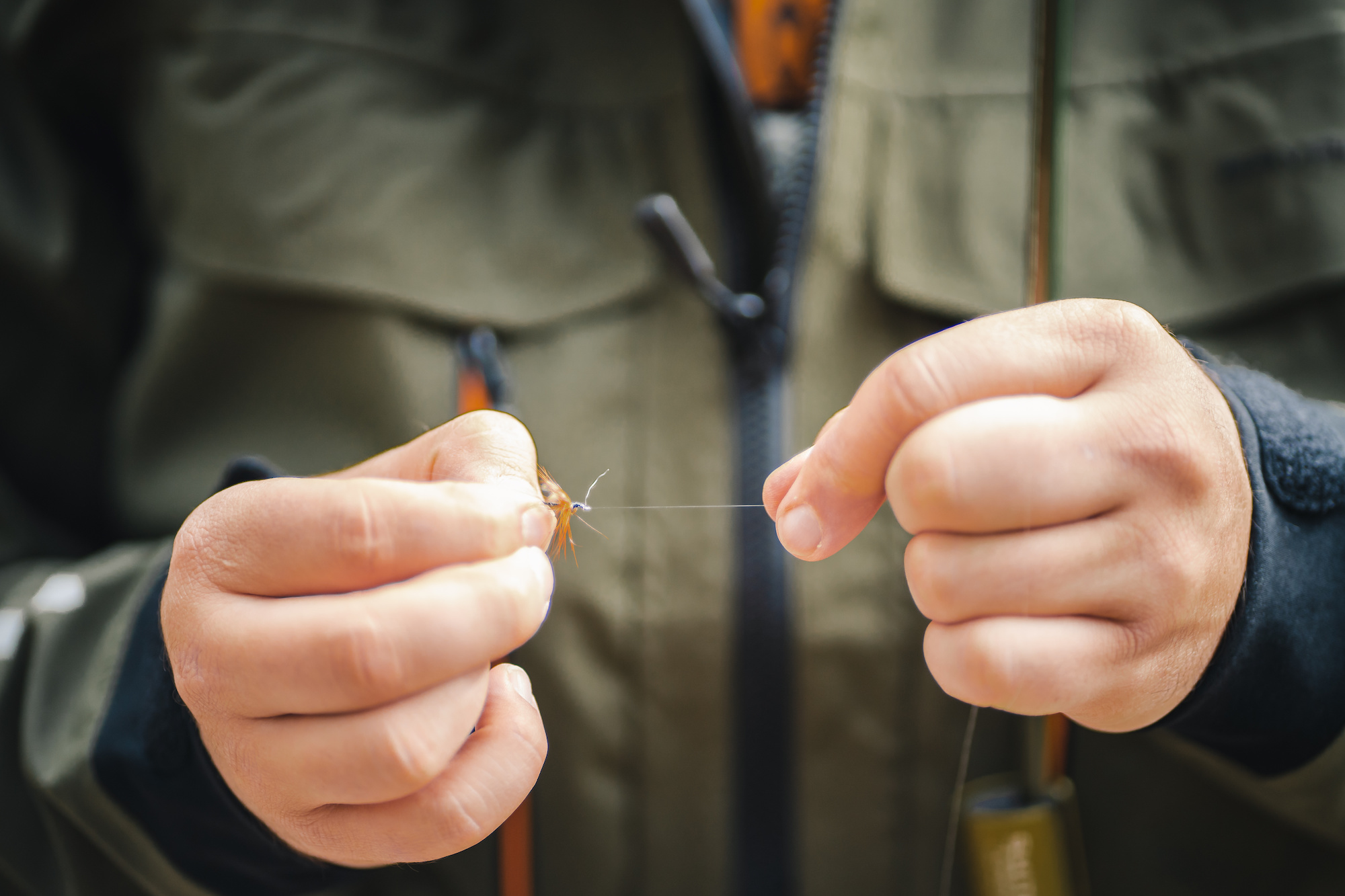
The double surgeon’s and blood knot are used for connecting two different pieces of leader or tippet material. The double surgeon’s is easier to tie, but some anglers prefer the sleeker blood knot because it passes through the rod guides more easily.
The improved clinch knot is used to tie a fly to the end of your leader. It’s easy to tie and it’s the knot I use the most. Some alternatives are the uni knot and the Palomar knot.
Casting Flies
You won’t catch a fish if you can’t get the fly out past your feet. Unfortunately, fly casting doesn’t come easily to most folks, and learning how to cast is one of the biggest deterrents for beginner fly anglers. (It’s even harder to learn if you’ve been fishing with conventional gear for a while.) But don’t let this deter you. If you can wrap your mind around a few basic concepts and put in a little practice, you’ll be fly casting in no time.
The most basic fly cast (and the best one to start with) is known as the overhead cast. It involves two main steps: the back cast and the forward cast.
To begin, hold the rod in your dominant hand and pull some line off the reel with the other hand—around 10 to 20 feet at first. Then, lift up with the rod and cast the line behind you, stopping when the rod is just past vertical and pausing until the loop unfurls in a straight line. When this happens, you’ll feel the weight of the line pulling on the rod as the rod tip bends slightly. This is called “loading” the rod. At this point, you can make a forward cast, which is the exact same motion as the back cast but in the opposite direction. The line forms a loop and unfurls in front of you as your rod stops just past the vertical position. You can then repeat this process, which is known as false casting, until you reach the desired distance and allow your forward cast to straighten out as the line falls to the water.

This basic casting stroke is also sometimes referred to as the “10 and 2” stroke. This has to do with the fly rod’s position when it’s stopped during the back cast and forward cast. If you picture a clock face, with the rod pointing straight up at 12 o’ clock, then the ideal stopping point for a back cast is around 2 o’ clock, and the ideal stopping point for a forward cast is around 10 o’ clock.
Executing a good overhead cast has a lot more to do with timing than strength. You must wait for the line to unfurl and the rod to load during the back and forward casts, and the more line you’re casting, the longer you have to wait. It also requires coordination between the two hands, as the dominant hand casts the rod, while the other hand controls how much line is being used. In time, casters can learn to use their off hand to “haul” on the fly line as it unfurls, which makes the rod load even more and puts more energy into the cast.
Pro tips for executing a good overhead cast:
- With your casting arm, try locking your wrist and keeping your elbow close to your side. Imagine you’re pounding in a nail with a hammer. This helps the rod tip stay on a straight plane, which keeps your loops tight and efficient.
- Make crisp, sudden stops when pausing during the back and forward cast.
- Use a metronome or count in your head to get a feel of how long to wait. (And remember that the more line you cast, the longer you’ll have to wait.)
- Watch your back cast. This will allow you to see the line unfurl as the rod loads, and you’ll lose fewer flies to trees.
- Practice fly casting in an open area on dry land before you try it on the water.
Once you master the basic overhead cast, there are many more casting strokes that can be learned and applied to different fishing scenarios. First and foremost is the roll cast, which eliminates the need for a back cast by using the surface tension of the floating line on the water to load the rod. (This is also the foundation for the style of spey casting that’s used with a two-handed rod.) Other, more advanced casts include the reach cast, pile cast, steeple cast, and the bow-and-arrow cast.
Presenting a Fly
Everything that follows the cast is what’s known as the “presentation.” This includes where the fly goes, how it lands, and how the fly is manipulated by the angler to elicit a strike from a fish.
Every presentation requires the two hands to be in sync: the dominant hand guides the rod, while the off hand controls the line. As soon as the fly hits the water, you want to pass the fly line through the trigger finger of your rod hand. You can then use your off hand to pull the line through the small gap between your trigger finger and the cork rod handle. This is known as “stripping” line.
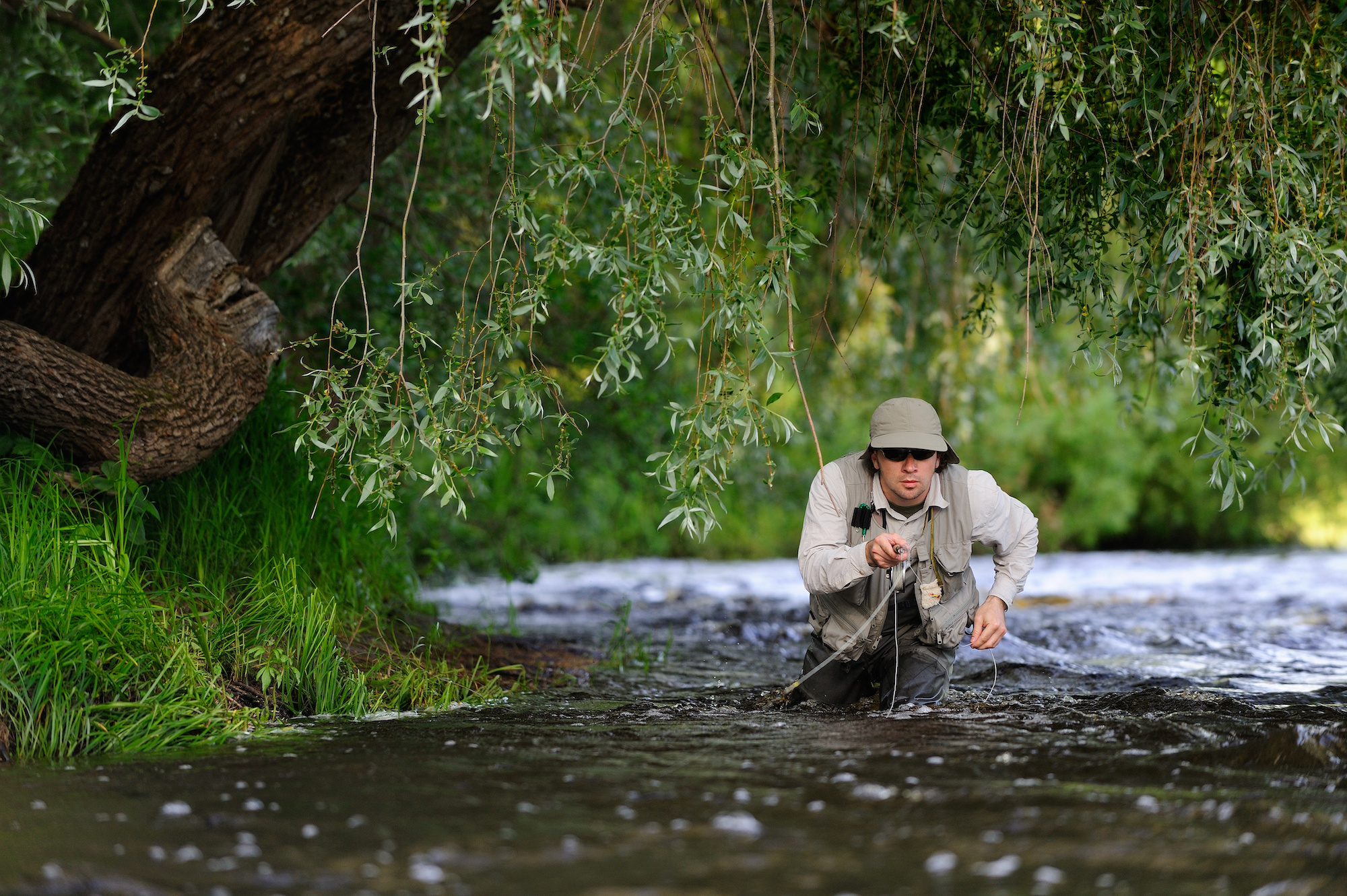
One of the standard presentations in fly fishing is known as the “dead drift.” This simply means letting the current control the fly as it’s carried along like a hapless bug or a fallen leaf. But it’s easier said than done when current comes into play, as conflicting currents will pull on the fly line and cause the fly to drag through the water, which looks unnatural. The solution is to mend the fly line, which involves adding slack and gently repositioning the line—but not the fly—to counteract drag. This presentation is most often used when fishing for trout with dry flies and/or nymphs, and it’s a balancing act that takes some practice. If you don’t have enough slack in your line, you won’t be able to achieve a drag-free presentation. And if you have too much slack, you won’t be able to come tight and set the hook when a fish eats.
Another way to present a fly is to fish it on a tight line. You can manipulate the fly by pointing your rod tip directly at it and stripping the line. This presentation is called for when fishing with a streamer or a topwater fly like a popper. It’s an effective way to cover a lot of water and find the most aggressive fish. Long, steady strips will impart more of a swimming action, while short, choppy strips will make the fly twitch and dart through the water. With this tight-line presentation, you’re fishing mostly by feel, and you’ll know when a fish grabs ahold of the fly. A bite can feel a lot like a snag, or it can feel like the rod is being jerked right out of your hand.
You can also present a fly by swinging it through a run. This involves casting the fly out like you’re dead drifting, but then allowing the current to pull the fly across the river and through a likely piece of holding water. Or you could euro-nymph, which involves making repeated and methodical dead drifts with extra-long rods and weighted nymphs.
These are just a couple additional examples of how to present a fly. The most common and effective presentations for most fishing scenarios are the first two listed above.
Hooking and Playing Fish
If you’ve made a good cast and presented your fly properly, there’s a good chance you’ll get a bite. The next step is learning how to set the hook. The two main ways to do this are by lifting up quickly with the rod, known as a “trout set,” or by stripping line firmly with the rod tip pointed at the fish, which is known as a “strip set.”
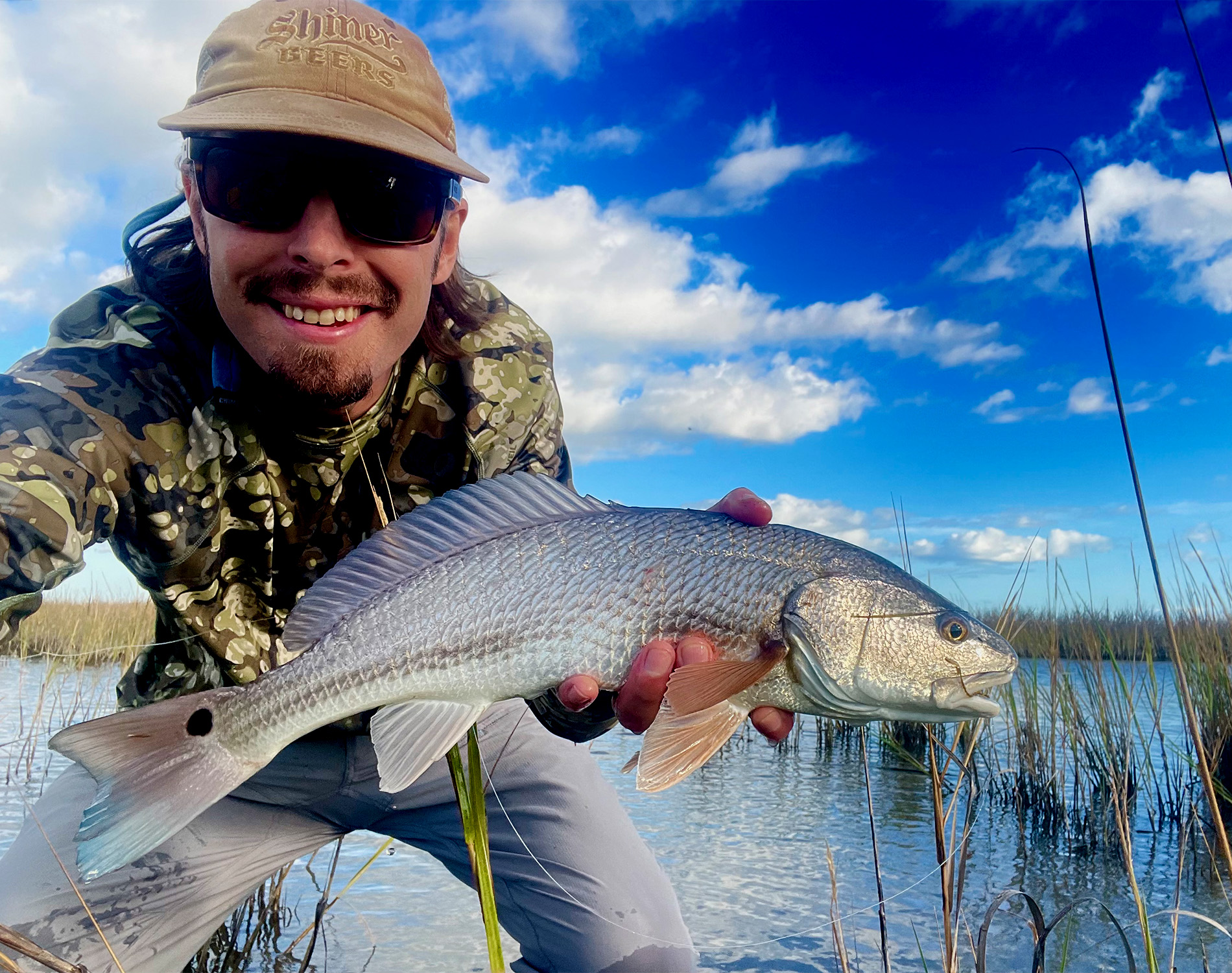
The first method is used when presenting dry flies and nymphs to trout, while the second is used when fishing with streamers and topwater flies for other species. The strip set is more effective in these situations because you can drive the hook home harder without the flex of the rod getting in the way.
When you do finally hook up, it’s time to play the fish and land it. This give-and-take requires you to keep the line tight and the rod bent, while allowing the fish to run when it wants to. If you don’t let the fish run, you risk breaking the line. Smaller fish can be stripped in by hand, but it’s best to use the reel when battling a bigger fish.
Fly anglers have more of a direct connection with the fish and less of a mechanical advantage compared to conventional anglers. They also tend to use lighter lines, both of which make it harder to wear out a strong fish.
Finding a Place to Fly Fish
Now that you have the basic gear and techniques required, it’s time to get out and put them to use. Luckily, we’re blessed in North America to have more fishable water than any one person could fish in a lifetime. Some of us are more blessed than others, but no matter where you live, there’s likely a good place to fly fish nearby.
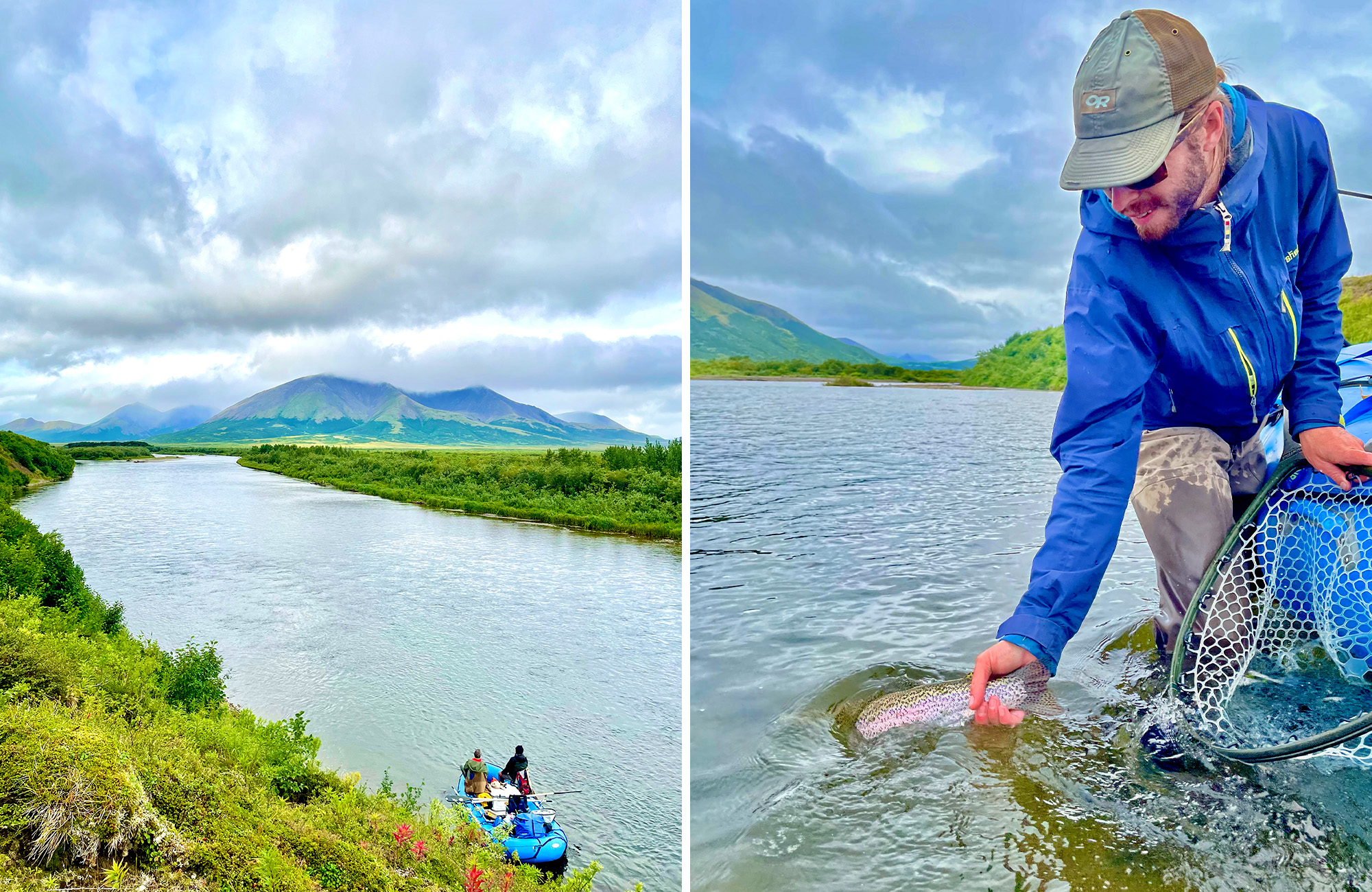
This is also one of the coolest parts about fly fishing: It’s a perfect excuse to explore. Just like hunting and other outdoor pursuits, fly fishing can become a lifelong adventure that will take you to some of the most incredible places on Earth.
Modern-day fly anglers are also fortunate to have so much technology at our disposal. The internet is a bottomless pit of fishing information. Along with modern satellite mapping and GPS apps, forums and other online resources make it easier than ever to find a place to fish.
In general, it’ll be easier to learn how to fly fish in freshwater than in saltwater because there’s much less water to cover and typically less wind; wind makes casting even more difficult. Fly fishing is also more effective in shallower water bodies than in deeper ones. And the one stage where a fly angler is most likely to out-fish a conventional angler is on a trout stream.
Smaller trout streams and bass ponds with stocking programs are good places to learn. And if you can find a farm pond with bluegills or other perch in it, start there. Many fly anglers (this author included) got their start fly fishing for sunnies and other panfish. They’re feisty, eager to eat flies, and easy to land.
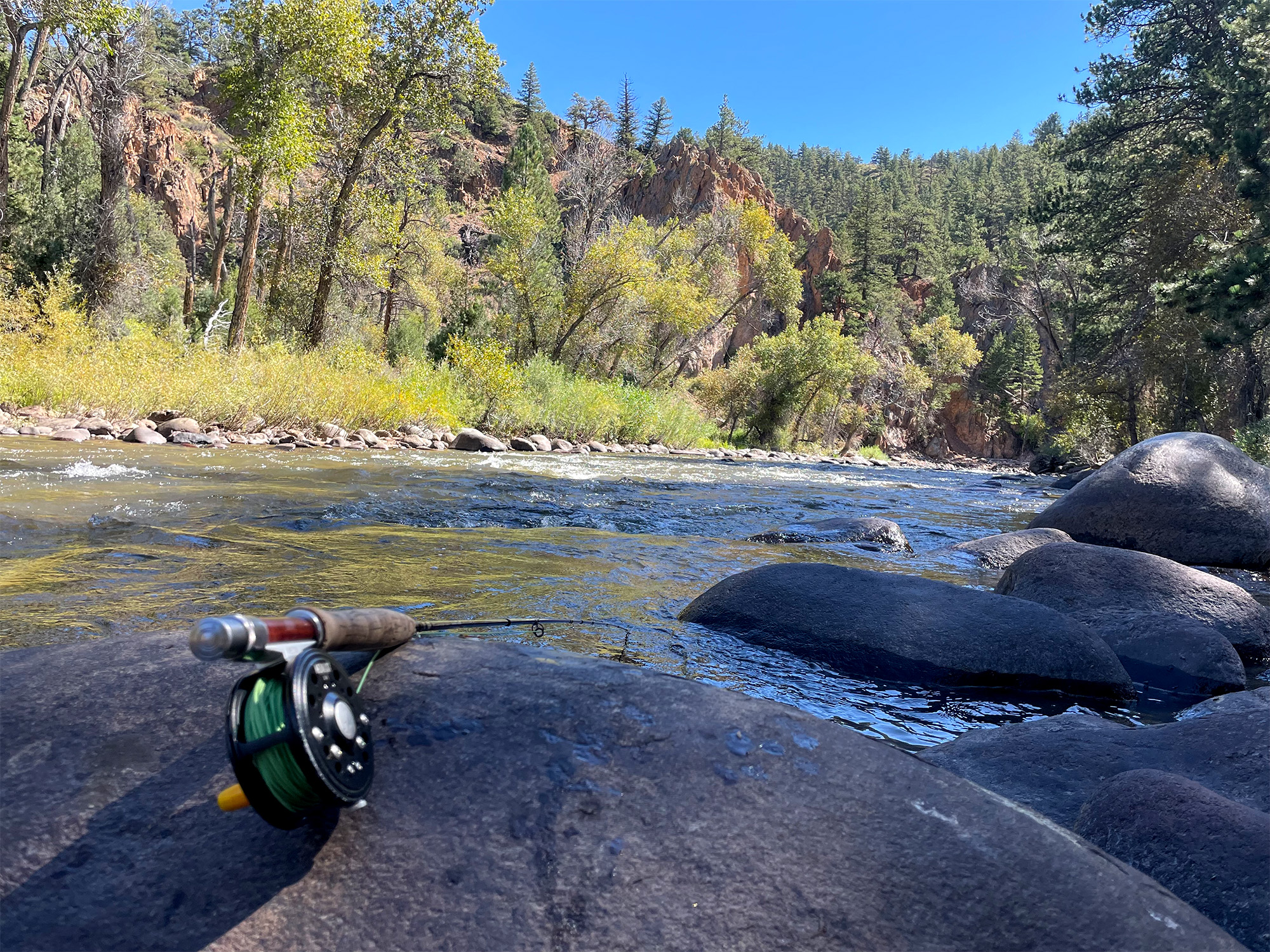
As with land ownership, it’s important to know if the water you want to fish is public or private. Water access laws vary drastically from state to state, so do your homework, study a map, and read your local regulations before you choose a spot. If you can get access to private water, you’re likely to find less pressure and more willing fish. Alternatively, if you can find a piece of public water that requires a bit of a hike to get there, you might be rewarded with some epic fishing.
One way to make all of this easier is by finding a mentor to take you out, or by joining a local fly-fishing club or Facebook group. Don’t be afraid to ask a lot of questions and accept the fact that you will get skunked. We’ve all been there.
Another way to shorten the learning curve is by hiring a fly-fishing guide for a day or two. The lessons you’ll learn are well worth the investment, and they’ll put you on a faster track to catching fish.
A Brief History of Fly Fishing
It’s hard to say how long humans have been fly fishing, but the earliest recorded mention of the sport goes back almost 2,000 years. In “On the Nature of Animals,” a text written by Roman author Claudius Aelianus and published around 200 A.D., Aelianus describes Macedonian anglers fishing on the Astraeus River, where “fish with speckled skins” gulp small flies off the water’s surface. To imitate these bugs, he writes, the anglers “fasten crimson red wool around a hook, and fix onto the wool two feathers which grow under a cock’s wattles.”
“Their rod is six feet long, and their line is the same length,” Aelianus continues. “Then they throw their snare, and the fish, attracted and maddened by the color, comes straight at it, thinking from the pretty sight to gain a dainty mouthful; when, however, it opens its jaws, it is caught by the hook, and enjoys a bitter repast, a captive.”
There’s also evidence that Native Americans engaged in some type of fly fishing well before North America was colonized. In 1741, naturalist William Bartram wrote about Seminole Indians catching largemouth bass using long sticks and deer-hair flies that were “nearly as large as one’s fist.”
With this history in mind, it’s possible that various elemental forms of fly fishing developed in sequence throughout different parts of the world. However, the first detailed description of the sport that we know today as fly fishing can be found in an obscure 15th century text written by a noble-born English nun, Dame Julia Barnes.
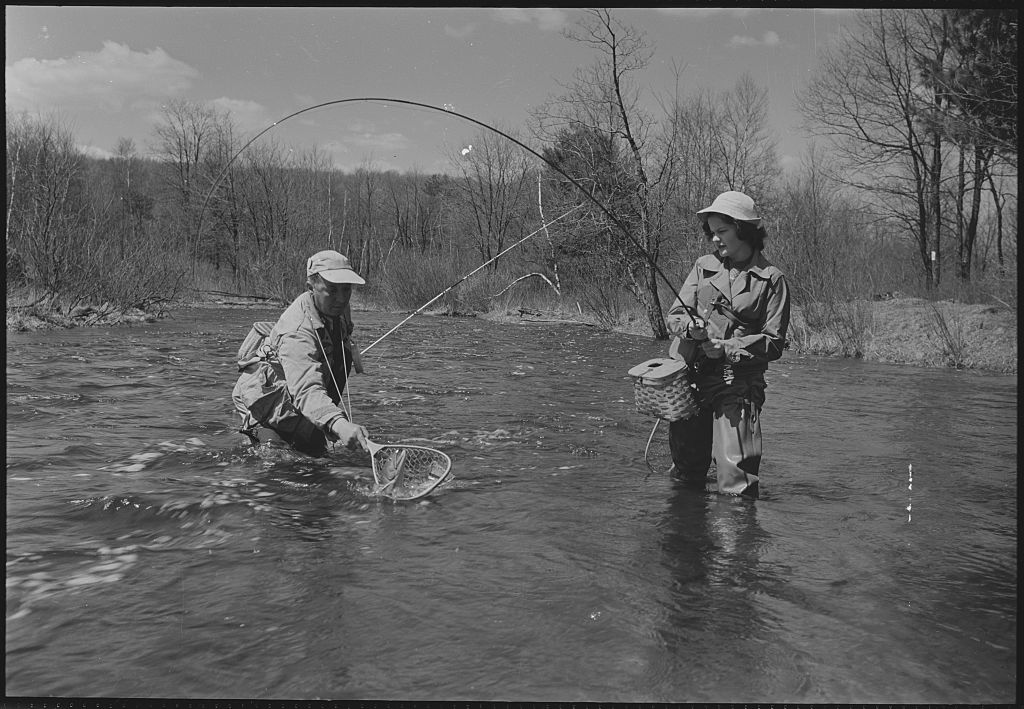
The work attributed to Barnes, A Treatyse of Fysshynge with an Angle, is now considered the first “how to” fly-fishing book ever written. And while historians have some doubt as to whether Barnes was a real person or simply a pen name, the work’s existence is unquestioned. It also proves that people in England were figuring out how to fly fish for trout sometime before the work was published in 1496.
Fly Fishing’s Formative Years
Roughly 150 years later, an Englishman named Izaak Walton wrote The Compleat Angler, which is now considered the seminal work in fly-fishing literature. It’s one of the most reprinted books in the English language, according to the Smithsonian Institute, and while it’s more of a contemplative work than a how-to book, it contains some gems like this one that are still quoted today: “God never did make a more calm, quiet and innocent recreation than angling.”
It’s the 300-year period from roughly 1600 to 1900 that we can refer to as the sport’s “formative years.” Fishing primarily on the chalk streams of England—which can be likened to the spring creeks we have here at home—anglers invented the basic fly-fishing gear and techniques that would come to define the sport. They started out using hand-made, tapered fly lines made from woven horsehair and gradually transitioned to lines made of silk. Leaders (the clear line that connects the fly line to the fly) were made of catgut, and eventually nylon. Rods were made of bamboo, and flies were simple creations made of string, fur, and feathers tied on a hook.
By the time Europeans were colonizing North America, the sport was well established, and Europeans began importing their favorite wildlife species, such as pheasants and brown trout. (The first brown trout stocking in America took place in 1884 on Michigan’s Baldwin River.)
During these formative years, and really for most of modern-day fly fishing’s roughly 500-year history, it was a sport reserved for nobles and the wealthier landowner class. This status remained when it was introduced here in the United States, where gentlemen sporting suits and ties fished for trout and Atlantic salmon in privately-owned rivers.
Thankfully, the sport’s stuffy, elitist reputation would slowly die (though not disappear altogether) as fly fishing experienced its own renaissance here in the U.S.
From Noblemen to Fishing Bums
Fly fishing’s transition from an elitist pastime to an everyman’s sport didn’t happen overnight, and remnants of tweed, pipe smoke, and snobbery remain deeply woven into the culture. But thanks to a handful of fly-rodding pioneers, who’ve passed the torch onto subsequent generations, fly fishing is now accessible to anyone with spare time and a few hundred bucks to invest in gear.
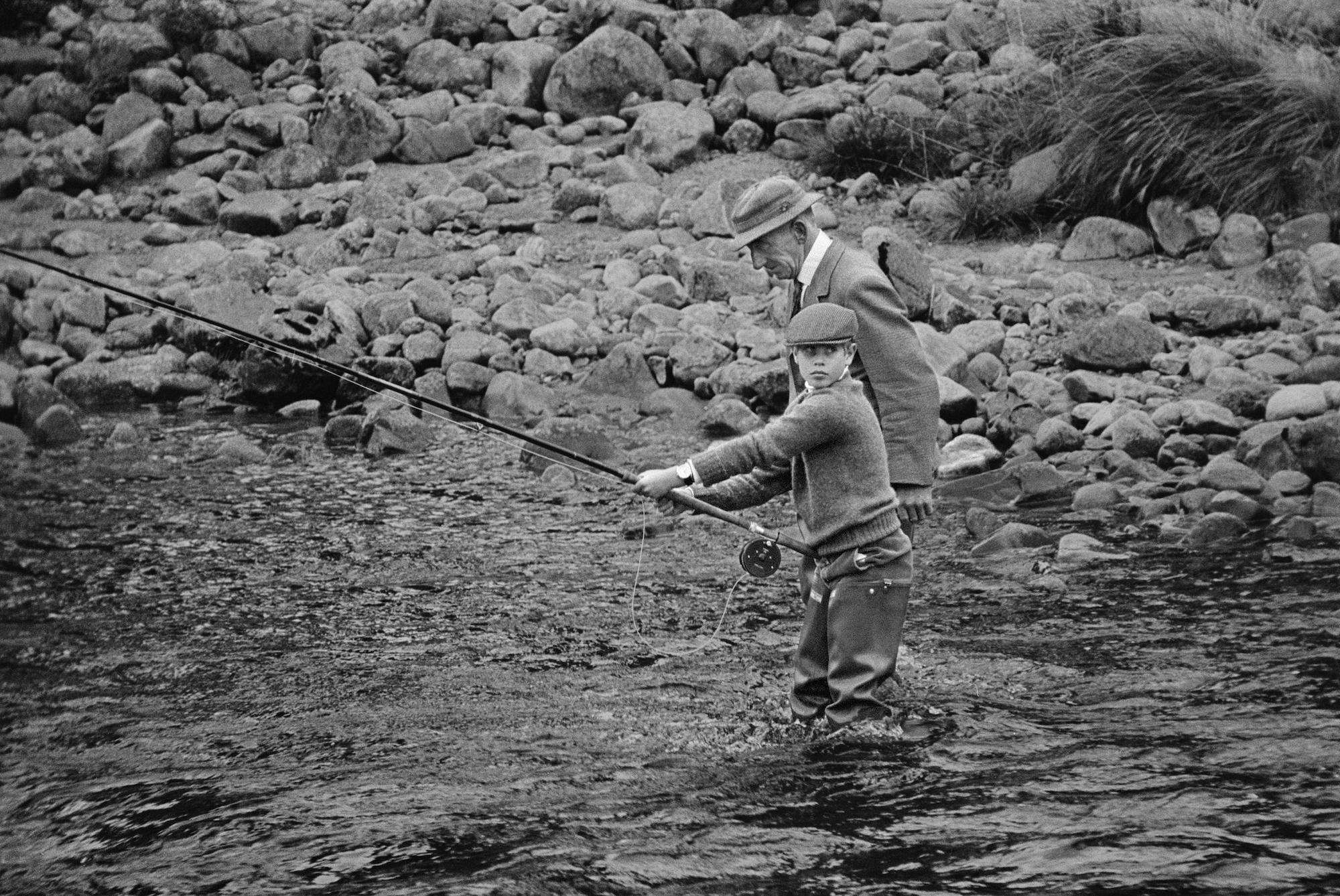
At the top of this list is a personal hero and former Outdoor Life fishing editor Joe Brooks, who arguably did more to popularize and expand the sport of fly fishing than anyone else during the 20th century. In addition to penning some of the best how-two books on fly fishing ever written, Brooks was an explorer who pioneered new places to fly fish, such as Argentina and New Zealand. Along with other notable figures like Mel Krieger, Ernest Schweibert, and Joan Wulff (also known as the “First Lady of Fly Fishing”), Brooks made fly fishing for trout accessible to everyday Americans for the first time.
Brooks was also one of the first people to cast a fly in saltwater and catch species like striped bass and bonefish. But it was his mentee, a gap-toothed Floridian named Lefty Kreh, who would bust those doors wide open. Fishing with his childhood friends Chico Fernandez and Flip Pallot, Kreh helped revolutionize the sport by moving far beyond trout fishing. Along with other forward-thinking anglers like Dave Whitlock, Kreh, and the others taught Americans how to catch bass on the fly. They invented new fly patterns, equipment, and techniques, and they pioneered fly fishing for tarpon, snook, redfish, and other saltwater species.
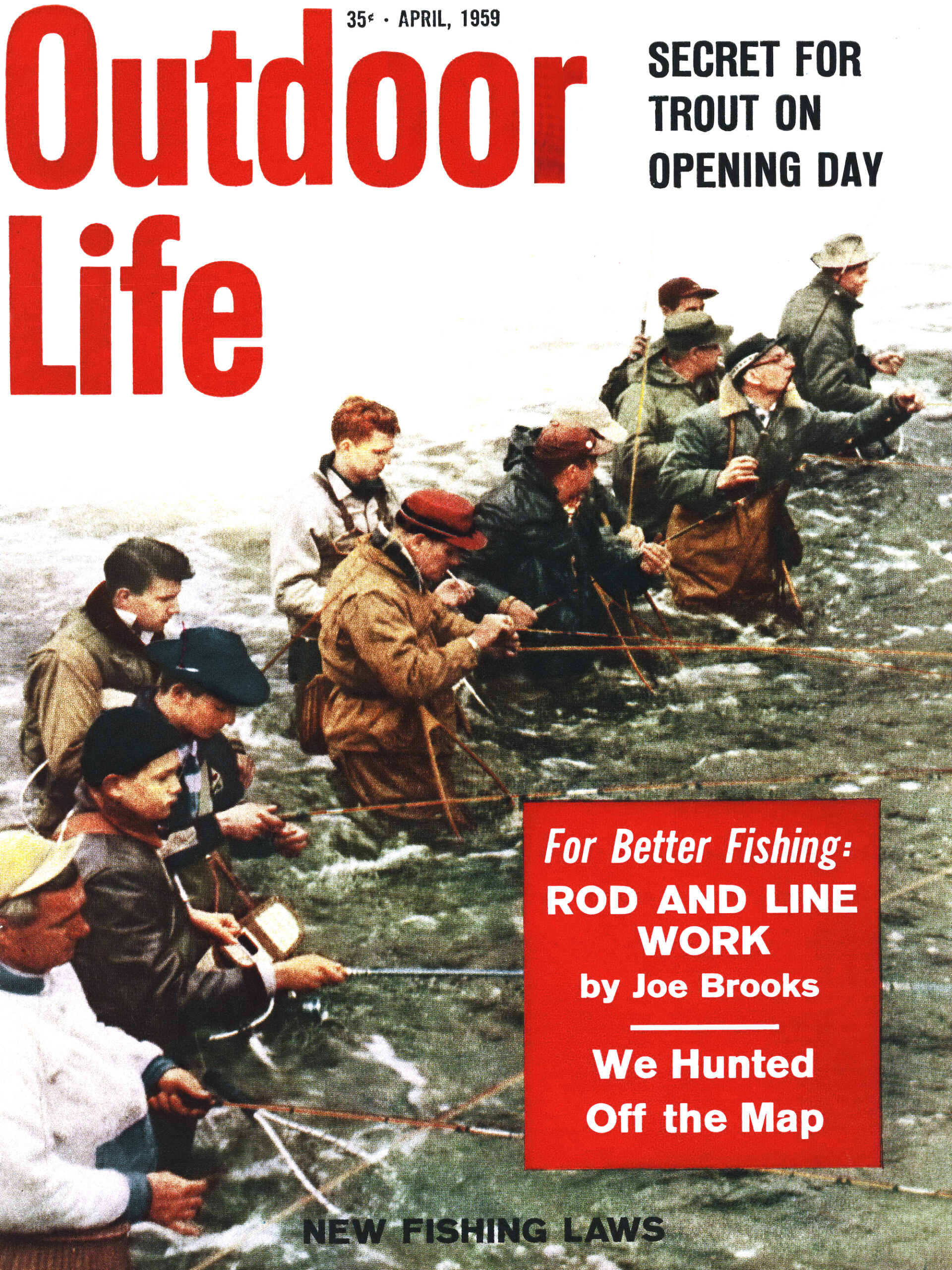
With their help, modern fly-fishing gear evolved by leaps and bounds over the latter half of the 20th century. Bamboo rods had long ago given way to fiberglass, and these were eventually replaced by graphite (the preferred material that most rod makers still use). Silk fly lines were replaced with the modern fly lines we use today, while monofilament fishing lines made in factories became affordable and commonplace.
Most importantly, thanks to the ingenuity of these legendary anglers, “flies” were no longer just bug imitations. They invented stalwart patterns like Lefty’s deceiver (invented by Kreh) and the Near-nuff crayfish (Whitlock), which work great on bass and other warm water species. Other tiers started using different materials to imitate all sorts of different prey items, and the advent of synthetics like foam, chenille, krystal flash, and rubber legs have only expanded these possibilities.
Read Next: The Best Fly Fishing Books
Meanwhile, as all these new-fangled flies and modern techniques hit the scene, fly fishing’s cultural rebirth was also underway. As more and more Americans took up fly fishing, the sport was seen less and less as a nobleman’s game. And by the time John Gierach coined the term “trout bum” in 1986, this transition was mostly complete. But it would take a Hollywood movie based in Missoula for fly fishing to truly enter the mainstream. With the release of A River Runs Through It, which is based on a 1976 story written by Norman McLean, fly fishing was suddenly, and surprisingly, cool.
Fast forward to 2023 and the multi-billion-dollar industry built around fly fishing has continued to grow. More than 7.8 million Americans went fly fishing in 2020, which represented a 42 percent increase from 2010, according to a 2021 Special Report on Fishing. The downsides of this surge in popularity are more crowds and increased pressure on rivers and other fisheries. The upsides are more work for fishing guides and other people in the industry, a growing number of voices in the conservation realm, and the fact that it’s never been easier to take up fly fishing.
FAQs
Although you can fly fish almost anywhere these days, it is especially popular anywhere trout can be caught. Some of the most popular freshwater fly fishing locations in the U.S. are found in Montana and other western states. Fly anglers looking for a saltwater fix typically head to Florida, Mexico, or other points farther south.
The best place to learn how to fly cast is in your own backyard or a nearby park. Once you get the cast down, your best bets for catching fish are in small farm ponds or trout streams with stocking programs.
Traditional fly fishing involves fishing for trout in a river with a dry fly. Bonus points if your rod is made out of bamboo.
Fly fishing can also be referred to as wasting time or shirking one’s responsibilities. Its practitioners are sometimes called deadbeats, snobs, wizards, or geeks.
Final Thoughts
Fly fishing is not the easiest or the most effective way to catch a fish. The draw of the sport is the challenge and the adventure that lies therein. Embrace these aspects. If you just want to catch a lot of fish quickly, or if you’re in it for the fillets, go buy a spinning rod and live bait. But if you ever get bored, fly fishing will be here waiting for you.

